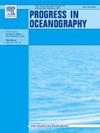气候变化情景下脆弱的棘皮动物 Leptometra phalangium 的栖息地迁移
IF 3.8
3区 地球科学
Q1 OCEANOGRAPHY
引用次数: 0
摘要
Leptometra phalangium(Müller,1841 年)的甲壳类海床被地中海渔业总委员会(GFCM)确定为敏感栖息地,因为它们极易受到底拖网捕捞的影响。由于 L. phalangium 对物理损害的恢复能力很差,因此已被列为地中海脆弱海洋生态系统 (VME) 的潜在指标。如果捕鱼活动是该物种栖息地遭到破坏的主要原因,那么气候条件的持续变化可能会迅速加剧这一过程。在这项研究中,我们建立了一个物种分布模型集合框架,以预测地中海 L. phalangium 目前的潜在栖息地,并利用该模型推断在两种不同的气候情景(IPCC 代表性浓度途径 RCP2.6 和 RCP8.5)下,到 2050 年其空间分布的潜在变化。我们使用了真实的存在-消失记录,并将其与一组被认为是底栖物种分布重要驱动因素的环境预测因子进行了关联。在目前条件下,L. phalangium 似乎广泛分布于地中海西部和中部的大陆坡。这种棘皮动物通常被描述为局限于大陆架断裂带(100-200 米),但我们的研究结果表明,它可以在更广的深度范围内(100-500 米)被发现。我们对 21 世纪中叶的预测表明,在未来的气候条件下,L. phalangium 的栖息地将大幅减少,主要集中在中部和南部盆地。与现在的预测相比,在 RCP2.6 和 RCP8.5 条件下,L. phalangium 的适宜栖息地将减少 50% 到 70%。气候避难所(即未来环境条件仍然适合该物种的区域)仅限于西北部盆地(如狮子湾、加泰罗尼亚海、巴利阿里海、利古里亚海)和亚得里亚海南部。有了可靠的统计框架,气候避难所预测以及不确定性评估必须有助于政府机构和区域管理组织确定保护脆弱海洋生态系统指标物种的优先区域。本文章由计算机程序翻译,如有差异,请以英文原文为准。
Habitat shifts of the vulnerable crinoid Leptometra phalangium under climate change scenarios
Crinoid beds of Leptometra phalangium (Müller, 1841) have been identified as sensitive habitats by the General Fisheries Commission for the Mediterranean (GFCM) due to their high vulnerability to bottom trawl fisheries. Poorly resilient to physical damage, L. phalangium has been listed as a potential indicator of Vulnerable Marine Ecosystems (VMEs) in the Mediterranean Sea. If fishing activities represent the main cause of habitat destruction for this species, the ongoing changes in climate conditions may rapidly exacerbate the process. In this study, we developed an ensemble Species Distribution Modeling framework to predict the potential habitat of L. phalangium for present-days in the Mediterranean Sea, and used the model to infer potential changes in its spatial distribution by 2050 under two different climate scenarios (IPCC Representative Concentration Pathways RCP2.6 and RCP8.5). True presence-absence records were used and correlated to a parsimonious set of environmental predictors considered as important drivers of benthic species distribution. In present conditions, L. phalangium seems to be widely distributed along the continental slopes of the western and central Mediterranean. This crinoid is often described as confined to the continental shelf-break (100–200 m), but our results show that it can be found over a wider depth range, between 100 and 500 m. Our predictions obtained for the mid-21st century indicate an important habitat loss for L. phalangium under future climate conditions, mainly in the central and southern basins. Declines of 50 to 70 % in its suitable habitat were predicted under RCP2.6 and RCP8.5 compared to present-day predictions. Climate refugia (i.e., areas where environmental conditions remain suitable for the species in the future) were restricted to the northwestern basin (e.g., Gulf of Lion, the Catalan Sea, the Balearic Sea, Ligurian Sea) and in the southern Adriatic Sea. Provided by a robust statistical framework, climate refugia predictions, along with uncertainty assessments, must support the identification of priority areas for the conservation of VME indicator species by governmental bodies and regional management organizations.
求助全文
通过发布文献求助,成功后即可免费获取论文全文。
去求助
来源期刊

Progress in Oceanography
地学-海洋学
CiteScore
7.20
自引率
4.90%
发文量
138
审稿时长
3 months
期刊介绍:
Progress in Oceanography publishes the longer, more comprehensive papers that most oceanographers feel are necessary, on occasion, to do justice to their work. Contributions are generally either a review of an aspect of oceanography or a treatise on an expanding oceanographic subject. The articles cover the entire spectrum of disciplines within the science of oceanography. Occasionally volumes are devoted to collections of papers and conference proceedings of exceptional interest. Essential reading for all oceanographers.
 求助内容:
求助内容: 应助结果提醒方式:
应助结果提醒方式:


